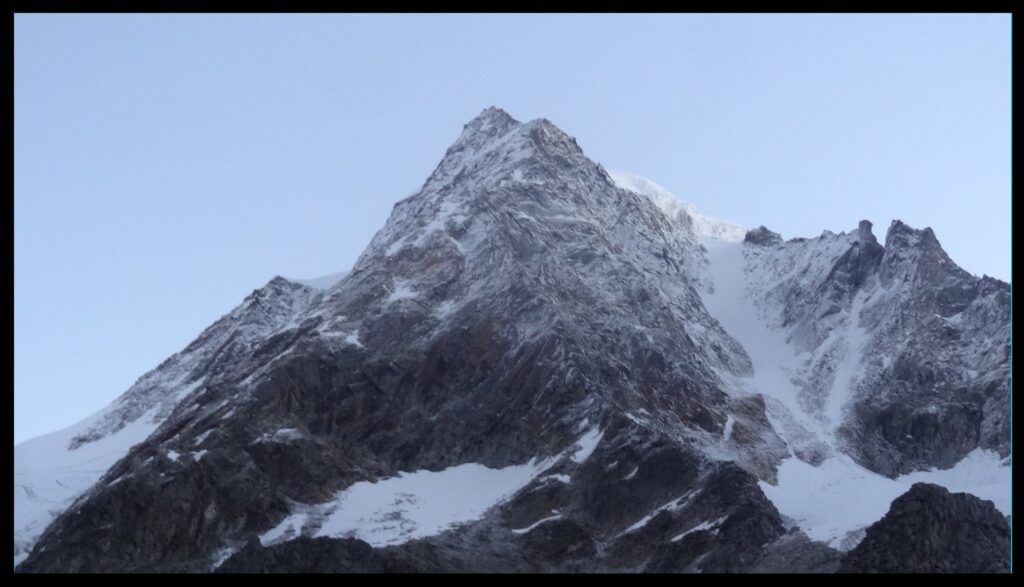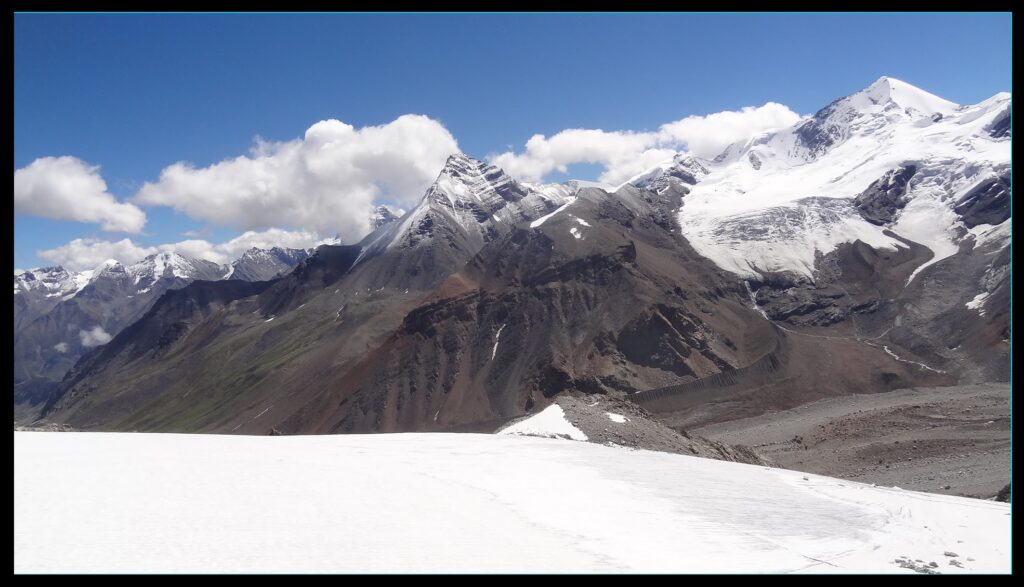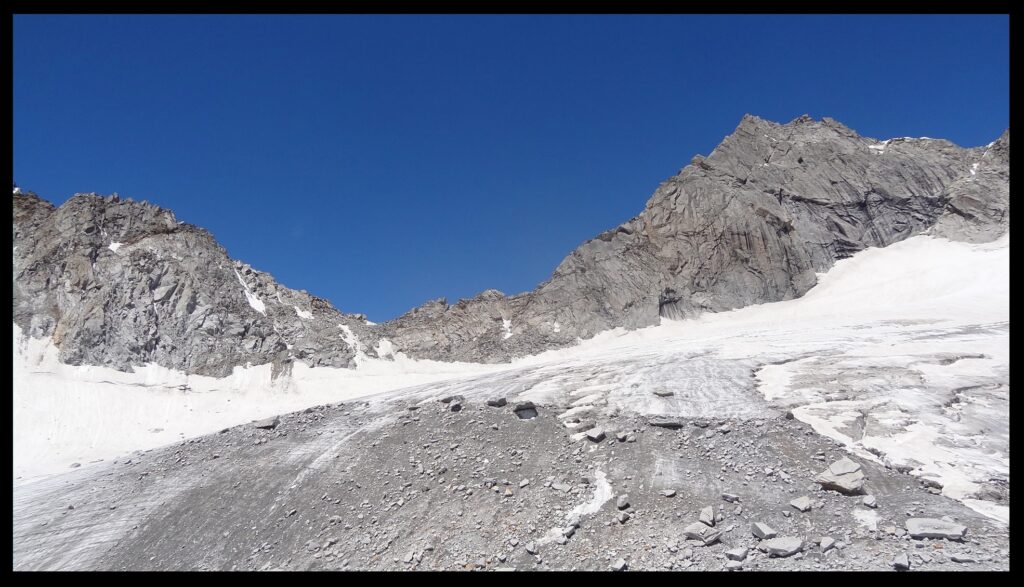On June 30th Kamal and I took a bus from Mussoorie to reach Sankri. We reached Sankri by 4PM. No jeep was available to Taluka village — the last village before Borasu pass — because of the rains. So we walked from Sankri — the last village having electricity supply — to Taluka for a couple of hours to reach GMVN guest house at Taluka in time for dinner (reached around 7 p.m).
Borasu Pass itinerary we followed
- 30th June: Bus/Jeep to Sankri and trek to Taluka
- 01st July : Taluka to camping place between Seema and Har ki Dun (31.12961N ,78.37957 E, 3056 M )
- 02nd July : Camping place between Seema and Har ki Dun to a meadow with huge boulder (for shelter) 1-2 kms before Morinda Taal (31.16700 N,78.42866 E, 3831 M)
- 03rd July : Boulder Camp 1-2 kms before Morinda Taal to Camp in glacial moraines before Sauni (Sauna) Bhera (31.21081N,78.44048E, 4358M)
- 04th July : Sauni Bhera to Upper Lamjunga Campsite (31.22260N,78.45603E,4745M)
- 05th July: Upper Lamjunga Campsite to Campsite at the end of Glacier(31.28034N, 78.48483E, 4172M ) on other side of Borasu Pass (31.23062N,78.46602E,5203M)
- 06th July: Campsite at the end of Glacier to Chitkul village (31.35115N,78.43695E,3436M)
Seema village to Har Ki Dun
On 1st July after a quick breakfast, we continued up to Seema village with lunch enroute at Ghangar. My friend Kamal, with a 25kg backpack, surprisingly lagged an hour or so behind me. Once he arrived at Seema we walked for another hour or so before camping. That night it poured “cats and dogs and its cousins”.
Luckily my tent was good enough and water did not seep through. July 2nd was an overcast day with a near whiteout. We walked to Har Ki Dun and then to a meadow 1-2 km before Morinda Taal.
The entire route beyond Har-Ki-Dun meadows is along the true right of the Morinda Gad (stream). The Morinda Taal is formed in an area where the Morinda Gad spreads out on flat land.


Since, it was drizzling and again a near whiteout it was no fun walking. So, we decided to wait it out that day. We camped under a huge boulder which was a natural campsite (also used by the shepherds).
The weather did not clear up today. I spent a restless night on July 2nd praying that the weather would clear up.
Har Ki Dun to pass base camp
July 3rd – The weather had still not cleared up fully but just enough to entice us into moving early, sans breakfast.
We self-guided ourselves with a GPS, printed map and followed the lay of the land to camp in the glacial moraines (boulder zones) beside a small glacial pond about 500M before Sona or Sauni (Sauna) Bhera (marked in map as Sorna Vir).
We had to camp here as the weather was turning bad (it was starting to drizzle). On 4th July, the weather was slightly better. We headed to Sona Bhera, which we reached in about 30-45 mins. Post that, we lost our way a little, courtesy a minor navigational error.
We lost 1 hour climbing up and down a side ridge and came back to Sona Bhera campsite. By this time the visibility was very low. None of the hills or ridges could be seen.
We again ventured along, which I thought was the right route. After about a 30-45 mins climb, beside a nala, based on my GPS reading I felt we were about 100 M left of where the actual trail is supposed to be. So we recced once again and soon we found the right trail.
We climbed on the trail, till what appeared to be the high camp at 4750 meters, amidst the boulder zone. There is a clear view of the ice-wall below the pass from this camp.
Crossing the Borasu Pass
As luck would have it, the weather gods were kind to us and on 5th July we awoke to a clear cloudless day.








We could clearly see the route to the pass. Broke camp as early as possible and trudged up to 5200M passes in about 3 hours. The last 50M-100M climb was a scramble on boulders and scree.
The views from the pass, looking back into the valley along the way we came, was spectacular to say the least. So, were the views of the glacier on the other side of the valley.
As per the map, though, the actual pass was further to the North-West, along the same ridge, by about 500-600M, at nearly the same elevation. It was a sharp, steep descent on boulders for about 150M or so. Then we had to cross a crevassed snowfield. The crevasses were mostly open and we could avoid most.









However, both Kamal and I each fell into a crevasse, each about waist deep on multiple occasions. On both occasions we were able to extricate ourselves from the crevasse. We suspected the route to be on our left but the snow/icefield seemed treacherous, so we got down a boulder zone on our right (as we descended) right into the glacier.
This was definitely not a path that was used. It was a tedious walk for the next 2 hours on the glacier. We had come to the left side of the glacier and I soon realized that we had to be on the other side of the glacier.
However, the glacier was too wide and so we decided to go further down till we somehow reached towards the snout, where the glacier narrowed to find an opportune place to cross it. Luckily, near a glacial lake, closer to the snout we found a way across the glacier.



There was an ice cave near the glacial lake too. From there on we walked till we reached a patch of green grass, which marked the beginning of the Jorya Garang (the stream which originated from this glacier and meets Bapsa river near Ranikanda Meadows of Chitkul village).
Luckily, we had crossed over as the stream was in such full flow that it would not have been possible to cross it downstream. There was a side stream (“khad”) which was in full flow and as it was late (around 6 p.m) we decided to camp here and cross the side stream the next morning, till the water would subside.
All in all it was a tough, arduous long day’s trek – made tougher by the fact that we did not have a guide and a 20+ kg backpack to boot :). The weather on this side of the pass seemed much better.
Descending to Chitkul
On July 6th we walked along the Jorya Garang and reached the ITBP outpost at Ranikanda meadows of Baspa valley, where we had tea and a bit of a rest.
Then we walked along the road, beyond the ITBP check post at Nagasti to reach Chitkul for a late afternoon lunch. Kamal, who has also done the Lamkhaga trek, said that this trek was far tougher than the Lamkhaga trek. My impression too is that this is not a very easy trek, especially if it is not an organized trek. However, this was a very satisfying trek.
- Temso – A High Altitude Sacred Lake in Kinnaur – September 13, 2023
- Khimloga (Khimlay) Pass Recce From Chitkul Side – September 7, 2022
- Borasu Pass Trek Log (Har-ki-Dun to Chitkul Traverse) – March 27, 2021


Leave a Reply